Lionel Trains Presents: Trans-Con! 
The first Transcontinental Railroad opened up the American West and ended the need for dangerous pioneer expeditions. So in a way, Knowledge Adventure’s Trans-Con!, an educational game about the railroad’s construction, is the real sequel to the spirit of The Oregon Trail.
Although the game is licensed by the model train set company Lionel, the actual trains aren’t the focus. Trans-Con! explores what the construction of the railroad was like. The game switches around between modes and perspectives, and while it occasionally goes off-topic, it always pulls from history to illustrate the West.
At the outset, you join either the Central Pacific or Union Pacific railroad company in a race to the center point of the track in Utah. The two companies have their own routes from either side of the country, complicated by terrain, wildlife, land ownership disputes, resource shortages, and cultural differences with settlers and indigenous tribes. The journey across the country plays as a series of construction games where you connect one town to another by placing railroad tracks on a map. The government allocates a few million dollars at a time to lay rails, and you solve situations as you encounter them based on the path you take.
There are strong, obvious parallels to The Oregon Trail here. Trans-Con! even has its own version of the river crossing dilemma – choosing the best way to pass through safely – in the form of raising different types of bridges depending on erosion. (It’s like you’re permanently, symbolically ending the problems faced by early settlers.) The situations you run into occasionally depend on random luck (treasure hunts are a crapshoot), but they all teach how to observe the environment, reach a conclusion, and take chances.
The game goes further than The Oregon Trail by drawing more on educational reference material for these problems. To talk with the Pawnee tribe, for instance, you must learn a few basic words in Plains Sign Language. If you want to dig a railroad tunnel through a mountain, you can read about the risks posed by different blasting methods. Those examples are pretty direct in their educational content, though sometimes the historical detail in these segments just gives the setting color and background.
All that can happen from these events is that you gain or lose a little money, rarely enough to matter, or restart the current section. The stakes are low. Despite that, each encounter still feels like an accomplishment. It’s satisfying to see what happens when you get too close to German settlers’ territory, round up a herd of wild horses, or build over a patch of quicksand. Combined with the general lack of consequences, that’s a good incentive to be more adventurous and explore other points of interest on the map. And then along the way, you develop critical thinking skills and learn about more about life in the Old West.
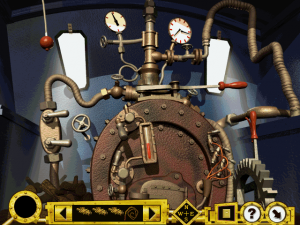
Side missions have small history-related puzzles, like this one based on a (probably) real steam engine
Trans-Con! blends the historical, educational content into its railroad game about as effectively as a kids’ game with silly voiceovers can, and it situates you in the period well, especially with touches like ambient ragtime, hymnal, and Native American music and a steam engine motif for the interface.
That’s the main thrust of the game. The other, less effective chunk of the game is a mystery story. Someone doesn’t want the Transcontinental Railroad built. They’ve stolen the commemorative golden rail spike that will join the two ends of the railroad, and they’re also trying to sabotage your work. Silly, for sure, and for an educational game in need of an exciting plotline, it does its job.
These side missions revisit an earlier segment of the railway, where a villainous henchman has gummed up the works with an easily fixable problem. The Dream Team – an intentionally diverse band of famous frontier heroes acting as your advisors – ride in to save the day. The sparsely designed levels borrow their style of presentation from pre-rendered role-playing games like Baldur’s Gate, just much sunnier and emptier and simpler.
This part might have been meant as a fun break activity for kids. (While still sneaking in some historical details about trains and the West, of course.) It looks like popular games from the time; frustratingly, it plays like an imitation. The unnecessarily big stages obscure what should otherwise be straightforward goals where players hone their problem-solving skills. There’s much less engaging here than the construction phase. At the least, the shift to a human-level perspective brings a flourish or two, like your character reacting to getting run over by a panicked horse, and backtracking to a previous leg of your trip is an interesting addition to the linear educational discovery adventure template that the Trail games and Trans-Con! belong to.
Once in a while, a mission ends with the Dream Team capturing one of the saboteurs, one of a menagerie of famous Old West baddies like Billy the Kid. Your teammate Sarah Casement will throw them in a jail car, loosen them up with helium (what’s with all these games that casually sprinkle in torture?), and help you question them to learn more about their leader. It’s very reminiscent of how Carmen Sandiego teaches history through deductive reasoning. Points to the game for coming up with a hilarious new moral compass for interrogating people: you can be polite, you can be mean, or you can be weird – saying nonsense at them to confuse them into accidentally confessing.
Knowledge Adventure did a lot within the framework of a train game endorsed by Lionel. Trans-Con! is a relatively clever, relatively fun educational game with its eye on capturing a certain moment in the era of American expansion.
…but there’s something else going on here. Billy the Kid and Jesse James, the most famous Western outlaws, are just the henchmen in this game. The suspects on the list of potential mastermind villains are bankers and business magnates. J. P. Morgan, Oakes Ames, Cornelius Vanderbilt, people who controlled industry and consolidated wealth.
The game has a journal of encyclopedic information about the West and the Transcontinental Railroad. Some of the social studies-type questions it asks seem more pointed than expected for a kids’ game that carries the name brand of an old, nostalgic hobby:
Who are the real heroes building the transcontinental railroad? The construction bosses? The politicians? The thousands of workers? Who are the real villains?
Who are the people who stand to profit from the building of the railroad? Who are the people who stand to lose?
How will the railroad impact the natural environment of the West? How do you feel about that?
So wait… did Lionel sponsor an anti-capitalist game for children?
That probably wasn’t the goal. For one thing, it doesn’t carry into the rest of the game. The encyclopedia entry for the Union Pacific company criticizes manager Thomas C. Durant for misspending government funds on his lavish lifestyle, but that doesn’t come up when you have to worry about money. The journal suggests that Native American attacks against you might be justified because the railroad endangers their way of life, but the game still casts Geronimo as one of the evil henchmen. Most of the other questions in the journal aren’t quite as incisive, and although it decries “the reckless competition between railroad crews,” the journal does point out the upsides for business of building the railroad.
Instead, it’s just a natural result of the game examining history at all. The Transcontinental Railroad was a boon, but it was destructive too, and the game acknowledges that. The millionaires who wanted to control the country are inevitably villains. Because those concerns are only kept in one ineffective, instructional corner of the game, few of the people who played Trans-Con! probably saw them, but they’re in there. Maybe they got one very curious kid to ask more questions about the rich and powerful. How’s that for critical thinking skills?

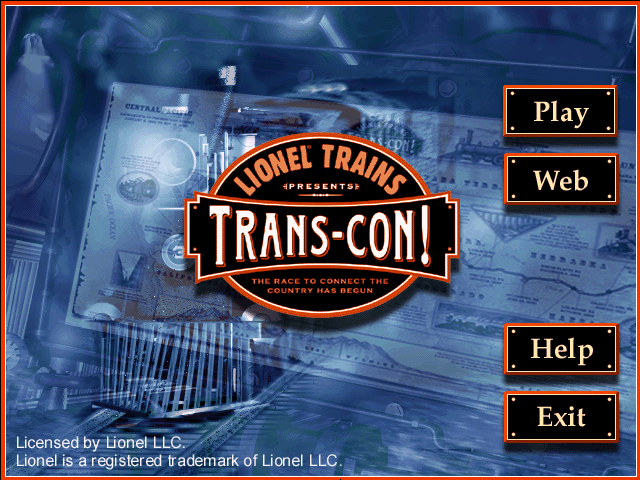
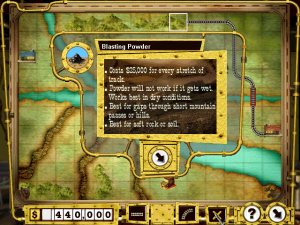
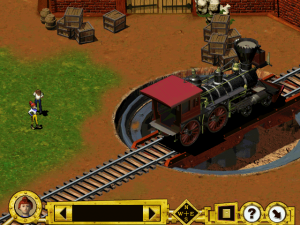
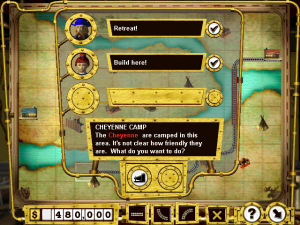
Hi.
I’ve been reading your nice blog for quite a long time, but feel I bad for never reaching back to you.
Thank you for good reads.
I’ve been trying to remember the name of this game for almost two years now! Thank you!
Pingback: Smilah Unedited Episode 18 - Nostalgic Video Gaming + Hypnotic Art